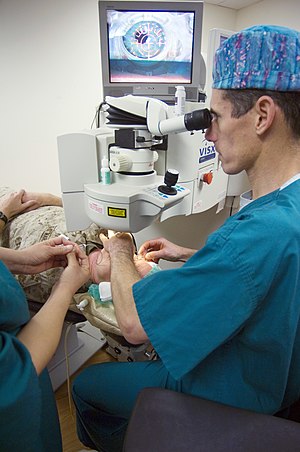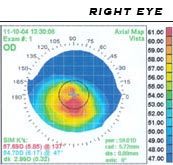Radial Keratotomy is a refractive surgery that’s used to correct nearsightedness (myopia). Typically the patients undergoing radial keratotomy expect to get rid of contact lenses and eyeglasses completely. Most of them do get rid of them in fact, however in some cases the complications may develop and the patients may need contact lenses to restore the visual acuity and to get rid of any visual disturbances that happened as a result of radial keratotomy.
Radial Keratotomy Complications
Radial keratotomy (RK) incisions may heal in a way that it results in greater myopia reduction, i.e. over correction, resulting in hyperopia. A significant number of patients undergoing radial keratotomy experience a shift toward hyperopia.
During the first month after procedure, slight visual fluctuations are common. They can be attributed to wound healing and variable depending on number of incisions and their depth. However some patients may develop constant hyperopia or other visual disturbances after the RK eye surgery and may need contact lenses for management.
Contact lenses after RK eye surgery
Visual acuity and performance gets affected in any procedure where there is under correction, overcorrection, epithelial growth, wrinkling, striae, etc. Any complication that causes irregularity in corneal surface can cause refractive errors and affect visual acuity. These irregularities may leave the cornea unable to be treated surgically and rehabilitative contact lenses may be the only option available to correct these errors.
Contact lenses that are used after the RK eye surgery due to complications include:
Soft contact lenses
Soft contact lenses can be of benefit in some of the post refractive keratotomy patients, however it may not be suitable for many cases.
Scleral contact lenses
Scleral contact lenses rest on the sclera of the eye without getting in contact of the cornea; therefore they are not affected by the corneal irregularities and maintain their shape.
The scleral contact lenses are made from the material that’s hyper permeable to oxygen. The scleral contact lenses maintain the saline reservoir between the cornea and the lens that bathes the cornea along with cushioning it.
Scleral contact lenses are helpful in correcting both nearsightedness and farsightedness along with astigmatism too.
Rigid Gas Permeable contact lenses
Rigid gas permeable contact lenses, as the name suggests, are rigid and oxygen permeable along with being comfortable as compared to their predecessors. Note that they’re rigid, not hard.
Gas permeable contact lenses can be made in any power possible and correct nearsightedness, farsightedness and astigmatism too.
Rigid gas permeable contact lenses are smaller than scleral and soft contact lenses and therefore provide better handling and comfort.
Global Complex Eye Care was specifically designed, equipped, and staffed to provide patients with nothing but the finest in professional eye care. As Post Radial Keratotomy RK Surgery Specialists, we have successfully treated patients with experiencing side effects and complications from Radial Keratotomy RK Eye Surgery , Keratoconus, LASIK side effects, Pellucid Marginal Degeneration, Stevens-Johnson Syndrome, and other irregular corneas. Optometrists and Ophthalmologists from all over Maryland and surrounding states refer patients to Dr. Irwin Azman.









